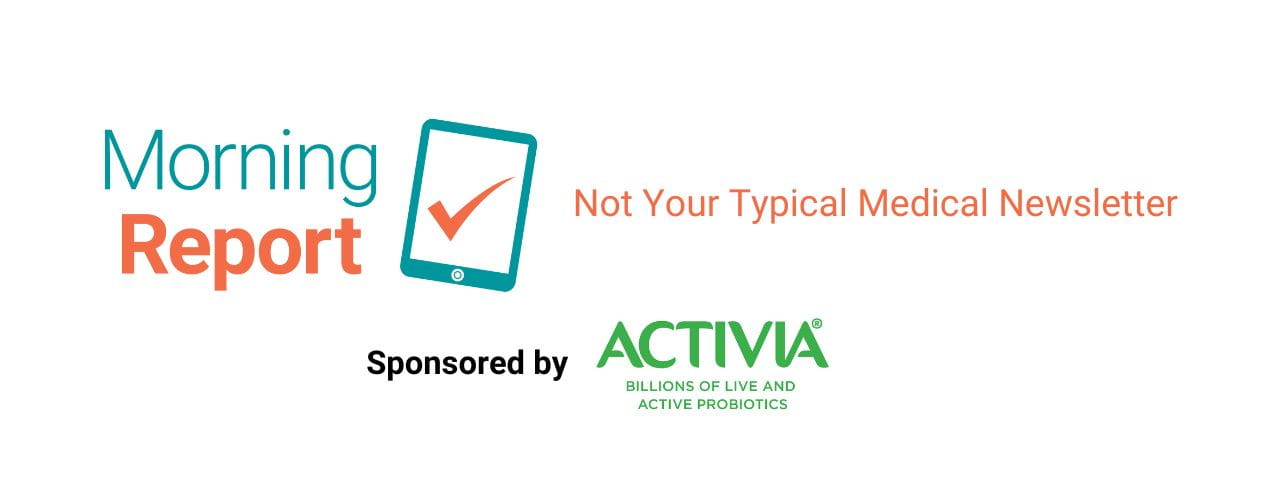
Published April 6, 2024
Morning Report — Not Your Typical Medical Newsletter
We get it, you see a lot of medical newsletters, so hear us out. Once a month, we’ll highlight important medical news sprinkled with witty commentary, fun facts, giveaways, and more… because learning should be fun! Subscribe to receive the Morning Report directly.
Awards season is now over, but before we furl the red carpet, let’s make sure you caught the highlights. Oppenheimer nabbed Best Picture, Taylor Swift won Album of the Year (and the year in general), and sulfites clinched the prestigious Allergen of the Year. Why sulfites? Because the American Contact Dermatitis Society (ACDS) recognizes a pest when it sees one. The ACDS cited literature that implicates this inorganic compound in numerous cases of allergic contact dermatitis; however, sulfite’s omission from most screening patch test series enables it to easily evade detection. And its Taylor Swift-esque ubiquity makes it hard to avoid. This allergen lurks in personal care products, topical steroids, pool water, rubber, and foods (think dried fruit, wine, bottled lemon juice, grape juice, etc.)
A Green Light for Red-Light Therapy in Glucose Lowering?
DIABETES DIGEST
Social media royalty Gwyneth Paltrow often delivers wellness advice that belongs in the healthcare dustbin, but her ongoing hype (along with that of countless other influencers) of red-light therapy may carry scientific weight. Investigators recently found that a particular frequency of red-light therapy on a person’s back may significantly lower their blood glucose levels.
What’s the frequency, Gwyneth?
A small, weeklong, placebo-controlled study of healthy adults showed that exposing the back to red light at a frequency of 670 nm for 15 minutes resulted in a nearly30% drop in blood glucose level from baseline. The intervention also aided in managing blood glucose surges, underscored by a 7.5% decrease in peak blood glucose levels. How does it work? Red light triggers energy production in the mitochondria, resulting in heightened consumption of glucose.
A blue wave
The study also highlights an emerging public health concern arising from a growing disparity in blue- and red-light exposure. The rise of the LED generation of lighting, characterized by predominantly blue waves, marks a shift toward increased blue-light exposure and may lead to potential health ramifications, including higher blood glucose levels.
Key takeaways
This study offers hope to patients with diabetes looking for a postprandial glucose-lowering intervention that is nonpharmacologic, noninvasive, and inexpensive (assuming they don’t opt for Gwyneth’s fully loaded infrared sauna). But researchers caution that red-light therapy in patients with diabetes is not yet ready for prime time. First, larger studies must both show how various light ranges affect patients with abnormal glucose levels and account for various levels of body mass index and adiposity.
FDA …
- Approves first drug for MASH
- Clears new automated insulin delivery system for T1D
- Clears first OTC continuous blood glucose monitor
- Gives breakthrough status to LSD-based medication for GAD
- Warns consumers against using some topical analgesics
Treating Anxiety/Depression May Help Patients with CVD Beat the Odds
CARDIO CORNER
Countless studies have explored the toxic relationship between cardiovascular disease (CVD) and anxiety/depression, with one condition often triggering the other. But no major study has shown the cardiovascular benefits of treating concurrent mental illness—until now.
Killing two birds with one stone
Researchers conducted a population‐based, retrospective, cohort design study of 1,563 Medicaid enrollees aged 22 to 64 with CVD and either depression or anxiety. Participants fell into one of these mental health treatment groups: (1) antidepressant medications plus psychotherapy, (2) psychotherapy only, (3) antidepressants only, or (4) no treatment. Over a three-year period, researchers noted heartening findings:
- Antidepressants plus psychotherapy slashed rehospitalization or ER visit rates by up to 75% and reduced all-cause mortality risk by ~66%.
- Psychotherapy alone cut the hospital readmission or ER visit rates by up to 53%.
- Medication alone dropped hospital readmission or ER visit rates by up to 58%.
But what would positive findings be without caveats? The study’s exclusive focus on Medicaid enrollees and its predominantly white participant base suggest limited generalizability to other racial or ethnic groups, as well as to patients covered by commercial insurance.
Key takeaways
With depression/anxiety often serving as CVD’s plus-one, it’s encouraging to see evidence that treating one improves outcomes in the other. This study is a ringing endorsement for adopting an effective collaborative care model, suggests lead study author Dr. Philip Binkley. “I hope the results of our study motivate cardiologists and health care professionals to screen routinely for depression and anxiety and demonstrate that collaborative care models are essential for the management of cardiovascular and mental health.”
Study Points Finger at Pulse Oximeter Inaccuracy in Darker Skin Tones
DISPARITY DISCUSSIONS
It’s fine to overestimate the wit of your Morning Report caption contest entry or the prowess of your alma mater in the NCAA tournament, but it’s not okay for a pulse oximeter to overestimate oxygen saturation (SaO2) levels. But a new study has unveiled this unsettling pattern in certain patients.
In a systematic review, investigators pored over 44 studies assessing the accuracy of pulse ox devices (totaling >700,000 readings) on various skin tones from the 1970s to today. (Important note: many of the early pulse oximeters studied have gone the way of 8-track technology.) Of the 222,000 people studied, nearly 70,000 reported non-white ethnicities. Consolidating statistics from 44 heterogeneous studies posed a challenge as daunting as untangling the web of solar eclipse conspiracy theories, but study authors did discern a few clear trends:
- Most studies revealed overestimation of true SaO2 by pulse oximetry.
- Patients with the darkest skin tones exhibited the highest magnitude of overestimation.
- The lower the SaO2, the greater the overestimation.
Key takeaways
What accounts for the discrepancy in pulse oximetry accuracy across skin tones? Experts suspect it’s due to the wide-ranging light source used and the diversity of skin tones included in the initial calibration studies. But the more pertinent question remains “What are the clinical implications?” Researchers can only speculate on that as well. They fear pulse oximetry may fail to detect hypoxemia in individuals with darker skin tones and affect crucial treatment decisions. Per study co-author Professor Eugene Healy “This systematic review highlights the need for clinicians to take account of a person’s skin tone as part of the clinical decision-making process when using pulse oximeters to estimate oxygen levels.”
SPONSORED BY ACTIVIA®
Activia® is the #1 doctor and dietitian recommended probiotic food and beverage product.* For the past 20 years, Activia has been pioneering probiotic research. Our yogurts and drinks are packed with billions of live and active probiotics and help support gut health.**
Visit ActiviaGutHealthToolkit.com for professional tools and resources for your patients.
*Based on a 2023 national weighted survey of 300 doctors (Primary Care, OBGYN, Gastroenterologist).
**Activia may help reduce the frequency of minor digestive discomfort. Consume twice a day for two weeks as part of a balanced diet and healthy lifestyle. Minor digestive discomfort includes bloating, gas, abdominal discomfort & rumbling.
Interested in more healthcare news? Here are some other articles we don’t want you to miss:
- 2024 ACC Expert Consensus Decision Pathway for Treatment of Heart Failure with Reduced Ejection Fraction: A Report of the American College of Cardiology Solution Set Oversight Committee
- Optimizing health after early menopause
- Cannabis use linked to increase in heart attack and stroke risk
- Apple cider vinegar results in weight loss, randomized study suggests
- Lying flat shows big benefit in large vessel occlusion (LVO) stroke
- Study finds daily fiber supplement improves older adults’ brain function in just 12 weeks
Morning Report is written by:
- Alissa Scott, author
- Aylin Madore, MD, MEd, editor
- Margaret Oliverio, MD, editor
- Ariel Reinish, MD, MEd, editor
- Emily Ruge, Author, editor
Would you like to share your feedback with Morning Report? Drop us an email at morningreport@pri-med.com to let us know how we’re doing.
Please note that the summaries in Morning Report are intended to provide clinicians with a brief overview of an article, and while we do our best to select the most salient points, we ask that you please read the full article linked in each summary for clarification before making any practice-changing decisions.
Enjoying Morning Report? Subscribe & Share It With Your Colleagues!
Is the Morning Report for you? It is if . . .
You're someone who needs quick-hitting, accurate medical news and you're a fun and witty healthcare professional who wants your news with some flare.
You don't just need to know about the latest metabolism study–you also need to know how it parallels an Alanis Morissette hit. If you're reading about acupuncture treatment, you need us to skip the needle puns and get right to the point. We keep things simple, but when we do get into the scientific weeds, we always remind you to check for ticks.
Subscribe to receive the Morning Report directly in your inbox the first Saturday of every month.
As a leader in CME/CE for 27+ years, Pri-Med provides evidence-based in-person and online CME/CE for primary care clinicians. Explore our education to earn credits and stay informed on the most current clinical strategies relevant to your daily practice.
SPONSORED BY ACTIVIA®
Activia® is the #1 doctor and dietitian recommended probiotic food and beverage product.* For the past 20 years, Activia has been pioneering probiotic research. Our yogurts and drinks are packed with billions of live and active probiotics and help support gut health.**
Visit ActiviaGutHealthToolkit.com for professional tools and resources for your patients.
*Based on a 2023 national weighted survey of 300 doctors (Primary Care, OBGYN, Gastroenterologist).
**Activia may help reduce the frequency of minor digestive discomfort. Consume twice a day for two weeks as part of a balanced diet and healthy lifestyle. Minor digestive discomfort includes bloating, gas, abdominal discomfort & rumbling.
